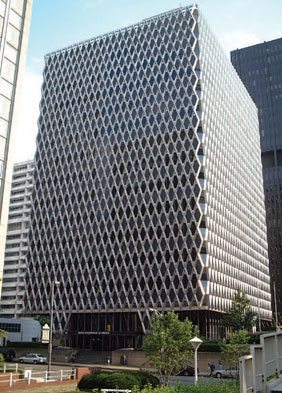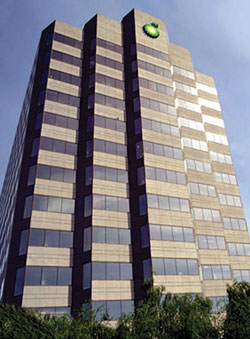Specifying Silicone Sealants: Providing Weather Sealing and Flexibility Between Building Components
Case Study Examples
Silicone sealants have an outstanding performance track record in building construction. There are many examples of buildings throughout the world that were sealed with silicone in the '60s, '70s, and '80s and that are still performing today.
A
Long-term Success Story: The US Steel Worker's Building, Pittsburgh, PA |
|
| This multi story office building was constructed and sealed over 40 years ago with a silicone sealant. The sealant was used to seal each of the metal-to-metal joints on the face of this spider web design. Even though it employed old acetoxy-cure silicone technology, which lacks the overall quality found in silicone sealants today, the sealant has retained good modulus characteristics such that it remains rubbery and is still performing. Today's silicone sealant technology is superior in terms of adhesion, modulus and movement capability. Nevertheless, the value of silicone for long-term durability and performance is quite evident in this building. | |
 |
 |
US Steel Workers Building in Pittsburgh, PA, more than 40 years of silicone sealant durability along metal joints. Photos Courtesy of Dow Corning Corporation |
|
Â
Helping to Achieve "Green" Building Design: Solano County Government Center, Fairfield, CACA |
| Designed to be energy smart and people friendly, the LEED-certified Solano County Government Center includes the new County Administration Center, Probation Office Building and an adjacent parking structure. The six- story $113.5 million project embraces many sustainable design characteristics including extensive use of solar electricity, energy efficient technologies, and a co-generation plant that has already earned honors for renewable energy. Because of the project's strong focus on energy efficiency and environmental sensitivity, the designers and consultants on this project were especially careful to choose sealants that could provide excellent weatherproofing capabilities and outstanding life-cycle value. The double caulk joints between the windows and pre-cast concrete were filled with a medium modulus silicone sealant without a primer installed over fire rated backer rod. Silicone sealant with a +/- 50 percent movement capability was also used for end dams, internal sealant work, the punched window units and some of the curtain wall units as well. [see opening photo on page 1] |
Â
Problem Remediation and Restoration: Brighton Condos at Kingston Plantation, Myrtle, SC |
| Built in 2001, this large 21 story complex began experiencing widespread water leakage problems soon after construction. An engineering study revealed failed sealant joints filled with urethane (organic) sealant and incorrectly used silicone sealant, as well as unsealed gaps around the stucco envelope's flashing and accessory points. The stucco facing also displayed isolated hairline cracking typically found on stucco-clad buildings. After cleaning and preparing the exterior surfaces, contractors applied 100 gallons of ultra low modulus silicone sealant around balconies and in stucco surface cracks and then resealed window and stucco joints with another 300 gallons of medium modulus silicone sealant. Lastly they covered the building envelope with about 2,500 gallons of silicone surface coating, without a primer, capable of spanning cracks up to 1/16-inch, accommodate movement and maintain its durability when exposed to sunlight, rain, snow and temperature extremes. The entire remediation required six months to complete with a crew of about a dozen workers. The building owners expect to save an estimated $1 million in recoating costs over 20 years. |
Â
Survivor of the Storm:
Exchange Square, Hong Kong |
|
| In spite of tropical heat and humidity, frequent heavy rains and typhoons, and the degrading effects of air pollution, Exchange Square is a prominent and enduring feature of the Hong Kong skyline. Constructed in 1984, it was the largest structural silicone project of its time. A high modulus structural silicone sealant was used to adhere the monolithic glass to Exchange Square's massive 200 meter (656 feet) tall towers. The sealant specified was shown to have been tested in impact glazing systems for use in hurricane and blast resistant installations. For more than 20 years, these sealants have been reported to perform as reliably as the day they were installed. This is particularly significant since the warm ocean waters of the Western Pacific and the South China Sea fuel some of the most powerful typhoons on earth. One of the strongest, Typhoon York, scored a direct hit on Hong Kong in September, 1999 − 15 years after this building was constructed. Sustained wind speeds reached 93 mph and the city remained under a Number 10 storm signal alert for a record 10 hours. |  |
Exchange Square, Hong Kong Photos Courtesy of Dow Corning Corporation |
|
Â
Standing Strong on Shaky Ground: BP Exploration Alaska Building, Anchorage, AK |
|
 |
Located in an active earthquake zone the 16-story BP Exploration Alaska building stands on shaky ground. Twelve seismic events of Richter magnitude 7 or greater have occurred during its lifetime. Yet the performance of the structural silicone sealant used in its construction has remained unshakable. When the building was erected in 1983, the architects specified a durable, flexible silicone sealant that could accommodate +/- 50 percent movement. This sealant was used to attach the insulating glass panels to the Kynar® painted metal in the building's two-sided, structurally glazed unitized curtain wall system. This proved to be a wise choice since, in addition to repeated ground tremors and earthquake activity, the structure has weathered 25 years of temperature extremes (-34 to 85 °F) and an annual average precipitation rate of 16 inches. |
BP Exploration Alaska Building, Anchorage, Alaska Photos Courtesy of Dow Corning Corporation |
|
Â
Â
|









